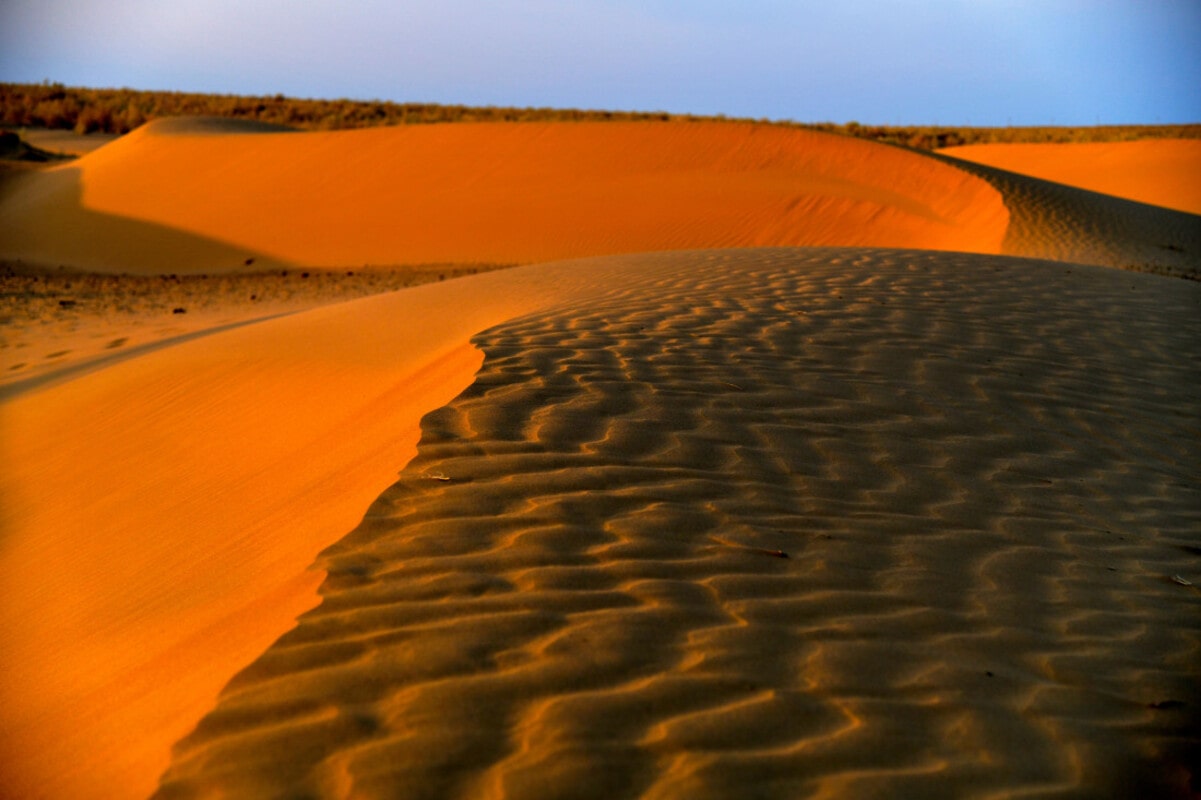The Kyzylkum Desert is one of the largest deserts in Central Asia, located between the Amu Darya and Syr Darya rivers. It stretches across the territories of three countries – Kazakhstan, Uzbekistan, and Turkmenistan. Despite its harsh climate, this region is geologically, ecologically, and culturally significant. Unique plant and animal species inhabit this arid land, while rich mineral resources lie hidden beneath the sands. Here are some fascinating facts about the Kyzylkum Desert that you may not have known.
- The name Kyzylkum comes from Turkic languages and means red sand. Its distinctive color is due to the high content of iron oxides in the sand. Under sunlight, the landscape changes hues from rusty orange to various shades of red.
- The desert spans approximately 300,000 square kilometers in area. It is the third-largest desert in Asia, surpassed only by the Gobi and Karakum deserts. This vast territory plays an important role in the region’s natural environment.
- The terrain is varied, with sand dunes, clay flats, saline marshes, and rocky zones. Its topography suggests that the region was once part of ancient sea beds. Evidence for this includes numerous sediment layers from different geological eras.
- The Kyzylkum has a continental climate characterized by extreme temperature variations. Summer temperatures exceed 50 degrees Celsius, while winter lows can drop below minus 20. Yet many organisms have adapted to survive in such conditions.
- Desert vegetation mainly consists of drought-resistant and salt-tolerant plants. Species such as saxaul, wormwood, and ephedra are commonly found. These plants typically have deep root systems that allow them to reach groundwater far beneath the surface.
- One of the most fascinating animals found in the Kyzylkum is the Central Asian monitor lizard. It can grow up to one and a half meters long and is protected as an endangered species. Its behavior and biology remain subjects of ongoing scientific study.
- Other rare animals in the desert include the saiga antelope, jerboa, ground squirrel, as well as desert lizards and bustards. Many of these species are endemic, meaning they are found only in this region. This makes the Kyzylkum ecologically valuable and worthy of conservation.
- Fossils of dinosaurs and other ancient creatures have been discovered in the desert. Cretaceous-era deposits provide insight into prehistoric ecosystems. Kyzylkum is considered a treasure trove for paleontologists.
- The region is rich in natural resources, including gold, uranium, natural gas, and other minerals. One of the world’s largest gold mines – Muruntau – is located in this desert. It plays a significant role in the economy of Uzbekistan.
- To protect the unique flora and fauna, reserves and protected areas have been established. The Djeyran reserve, for example, focuses on breeding endangered gazelle species. These efforts show how conservation can succeed even in harsh environments.
- In ancient times, the Silk Road passed through the Kyzylkum. Archaeologists have found remnants of ancient fortresses, ceramics, coins, and settlements. These discoveries highlight the historical importance of the desert.
- Some nomadic communities still live traditional lifestyles within the desert. They herd camels, sheep, and goats, moving seasonally between grazing lands. Their way of life reflects the cultural heritage of Central Asia.
- Scientific stations in the region study desertification, erosion, and plant adaptation. Findings from these studies help develop strategies for environmental protection. Kyzylkum thus serves as a living laboratory for ecological research.
- Tourism in the region is growing slowly but steadily. Nature expeditions, photography tours, and cultural visits are becoming more popular. Expansive landscapes and the opportunity to observe nomadic traditions attract visitors from around the world.
- The night sky over the Kyzylkum is exceptionally clear and free from light pollution. The Milky Way, constellations, and planets are easily visible. This makes the area ideal for astronomers and stargazing enthusiasts.
- Anti-desertification initiatives include planting saxaul trees and retaining soil moisture. These are effective measures to combat land degradation. Such ecological projects improve environmental resilience and support local sustainability.
These amazing and thought-provoking facts show that the Kyzylkum Desert is far more than just sand and heat. It is a region filled with life, history, and scientific promise. Understanding and protecting it is crucial for future generations and global natural heritage. Kyzylkum still holds many secrets waiting to be uncovered.





